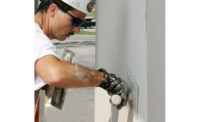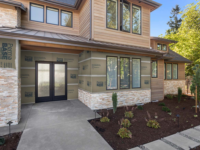When water penetrates or forms within a building’s wall assembly without an avenue to escape, it can be the catalyst for a host of issues that can compromise the integrity of the structure. From mold growth to rot and insect infestation, the problems associated with moisture intrusion can lead to financial and health repercussions that can ruin the reputation of the builder. For example, the case of a Florida municipal building where only a few weeks after opening, employees began complaining of chronic sinus problems, allergy attacks and headaches and asthma, ultimately resulting in $20 million of repairs and other associated costs1.
The undermining cause of these symptoms was severe mold growth, a direct result of excess moisture in the building, caused by a combination of rainwater leaks and a HVAC system that pulled moist outside air into the building during the hours when the cooling system had cycled off. Once the HVAC system became infected with mold, it dispersed spores throughout the building, infecting the indoor air quality of the enclosure.
One of the surest ways for excess exterior water to find its way into a building is through the building enclosure. Faulty installation, non-compatible products and under-performing materials are often the culprits in these failed systems. In order to avoid these issues building designers must understand the main causes of moisture intrusion:
- Rainwater intrusion
- Infiltration of outside moisture-laden air
- Internally-generated moisture
- Vapor diffusion through the building envelope
To prevent each of these causes, builders need to employ a systematic approach to moisture management to restrict bulk water from entering into the building envelope. Primary water management strategies should include water-deflecting components such as overhangs, eaves and durable exterior claddings. Equally important is the inclusion of an integrated weather resistant barrier and flashing system, which is used to help protect structures from air and moisture intrusion.
Beyond mold growth, unwanted moisture can cause a range of damaging problems affecting the durability, indoor air quality and thermal efficiency of a building.
Fortunately, moisture problems can be reduced through proper design, product specification and construction of exterior wall assemblies. This article will review the role housewrap systems play in protecting homes and buildings from the damaging impact of water intrusion.
Not all Housewraps are Created Equal
They differ in performance and value. Sorting out this array of options and performance claims, coupled with the installation requirements of housewraps can be a challenge to builders. Today’s housewraps are separated into two general types, non-perforated and perforated. Perforated housewraps are usually created from a woven slit-film fabric with a polypropylene film coating, similar to the blue tarps sold at building supply superstores.
To achieve breathability, small holes are punched through the film. Non-perforated housewraps are either a spun-bonded polyethylene or a fiber-film composite. Non-perforated housewraps use a high level of micro-porosity or water vapor diffusion capable polymers to achieve breathability. These structures are the result of the polymers and the equipment used to manufacture the product and do not require the punching of holes to achieve performance.
The non-perforated technology typically gives them superior bulk water holdout and superior air flow resistance, allowing moisture vapor to escape from the inside the building, while preventing outside precipitation from entering the building.
Housewrap products should be evaluated on the following basic performance factors: Air and water holdout, perm rating, durability, compatibility and proper installation.
Air and Water Holdout
Housewrap, when installed properly, acts as a secondary layer of defense against the elements of nature for a home or building. It performs several equally important functions.
First, it keeps water from coming into contact with the structural sheathing and framing during construction and after the building is complete. If wood framing or sheathing is exposed to moisture it can rot, resulting in structural damage. In addition, when wood is wet it can become a food source for mold growth, which significantly degrades indoor air quality.
Secondly, some housewraps also function as an air barrier to stop the movement of hot and cold air through the wall cavity. When used as a system with the joints and seams sealed properly, housewrap can reduce utility costs and increase indoor air quality by minimizing air infiltration and potential drafts.
Surfactants – Surfactants are found in a wide range of materials including wood tannins, cedar oils and turpentine within some cladding, as well as soap solutions used to pressure wash vinyl or other siding. These chemicals reduce the surface tension of water and allow it to flow more easily through the pore structure of the housewrap, consequently decreasing its water holdout. The result is the sheathing is no longer protected from wind-driven rain and water damage. Because not all housewraps are surfactant resistant, builders should look for the highest surfactant resistance housewrap to protect structures, especially when installing under vinyl and wood siding, brick, stone and stucco.
Perm Rating
Moisture Vapor Transmission Rate is the rate at which moisture vapor can pass through an object. It is reported as permeance or perm rating and is one of the most important factors to look for in a housewrap. Perms represent the number of grains of water vapor that pass through a square foot of material per second. Current building codes require a housewrap match or exceed Grade D building paper’s rating of about 5.0 perms.
To meet this requirement, perm ratings for commercially available housewraps range from 7 to 59 perms. There are favorable arguments for lower-perm barriers, notably in climates with high, solar-driven vapor and with absorbent exterior cladding materials, such as stucco, stone and brick. In the recent paper, “Inward Drive – Outward Drying,” building scientist Joseph Lstiburek identifies the “sweet spot” for the permeance of this WRB layer as between 10 and 20 perms2.
Durability
Tear resistance – To be effective, a housewrap must remain in place after installation. Many housewraps can be torn by the wind or ripped by the rigors of the job site. This requires reinstallation or significant repair to ensure best functionality of air and water holdout, and costs the builder profits and delays the project.
Ultraviolet (UV) stability – Even the smallest amounts of UV exposure can cause some housewraps to deteriorate. Because of this, technologically savvy manufacturers have begun to place UV inhibitors in the coating and fibers of their housewrap products. Most builders cover housewrap shortly after installation with exterior cladding. However, the prudent builder looks for a housewrap with at least a six-month UV rating.
Compatibility
Compatibility of flashings and construction tape used during installation should also be taken into serious consideration. Sealants with high solvent or plasticizer content for example, can damage bitumen flashing products causing functional and aesthetic issues. To counter this problem some manufacturers have developed a system approach that includes compatible tapes for seaming as well as adhesive flashings and panel products for wall penetrations that can sometimes leave the building envelope vulnerable. A compatible, properly installed system vastly improves air and moisture resistance with virtually no problems. Several forward thinking, customer-focused manufacturers back their systems with a warranty.
Proper Installation is Key
No matter what material you choose, proper installation is critical in order for a WRB to work as intended. Even if the barrier meets all code requirements, performance of the material can be compromised by incompatible tapes and flashing or improper installation.
Sealing all laps and penetrations with the proper tape can improve the housewrap’s performance by 20 percent. Any tears and holes should be sealed with manufacturer-recommended tapes and all windows and doors should be properly flashed. The goal should be to create a continuous building envelope free from any penetrations through which air could potentially move.
It is also important that the proper nailing pattern is followed to ensure the material is kept against the wall and will not be blown off during installation. Cap nails or staples should be used to attach the air barrier material to the structural sheathing and framing. Following this practice will allow for fewer nails and a stronger attachment. Uncapped nails, staples or screws can contribute to tearing and moisture intrusion—so don’t overlook these important details.
Conclusion
Attention to detail when designing and/or constructing a wall assembly is the ounce of prevention that can help protect against damaging moisture, whether it originates inside or outside of the building. A water-resistive system that includes proper flashing and sealing around fenestrations help improve building durability, indoor air quality and decrease maintenance costs by reducing the risk of moisture intrusion. In addition, by acting as an air barrier that prevents hot and cold air movement through the wall cavity, weather resistant barriers also help reduce utility costs and increase comfort.
1 MacPhaul, David, and Christy Etter. “Moisture Management.” WBDG Whole Building Design Guide, 11 July 2016, www.wbdg.org/resources/moisture-management.
2 Lstiburek, Joseph. “BSI-061: Inward Drive – Outward Drying.” Building Science Corporation, 15 May 2017, buildingscience.com/documents/building-science-insights/bsi-061-inward-drive-outward-drying.








Report Abusive Comment